
The rainy "dry season" has been followed by more typical Spring weather. Morning clouds carry a promise of even more rain:
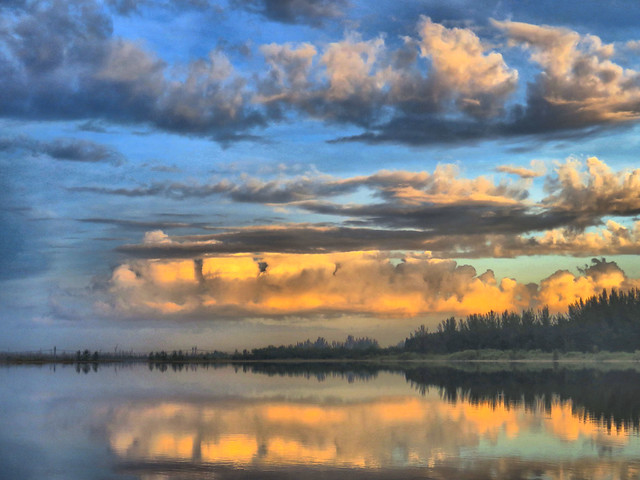
As related in this earlier post, Bald Eagles trying for a family again, our local Bald Eagles failed to breed last season during the winter of 2014-2015. The new female of the pair was young and inexperienced and never seemed to exhibit a brooding instinct.
Bald Eagles usually breed only once in a season, as the rearing and training of an eaglet takes about 4 to 5 months after the egg is laid until it gains independence. Second broods occasionally occur if a nest or eggs are destroyed early during incubation, and rarely after the loss of eaglets.
However, this year, because of unusually severe weather during January and February, 2016, several pairs of Florida's eagles have produced second broods. Our local pair hatched out at least one eaglet but it was probably injured and lost by January 20.
This season, Jewel, the female of the pair, laid her first egg on or about December 13, 2015. This egg was expected to hatch in 5 weeks, around January 17. Unfortunately, several severe thunderstorms with winds up to 80 MPH roared through in January, depositing broken branches over the right half of the nest. Since the nest tree is a very limber Australian Pine, the wind surely whipped it about severely. This photo shows damage to nest on the afternoon after the January 17 storm. Adults kept sitting on the nest and tried to move the fallen branches:
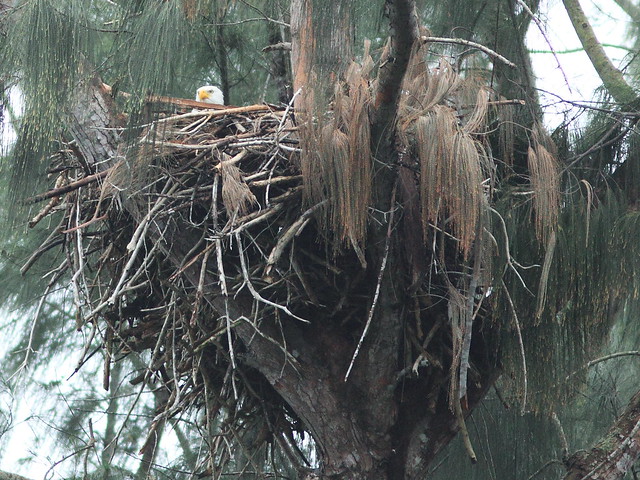
On January 19 there was clear photographic evidence that at least one eaglet had survived the storm and was being fed by Pride, but this was the last sign of life in the nest:

Presumably the newly hatched eaglet sustained injuries which proved fatal, and any other eaglets or eggs were lost. The pair of eagles never abandoned the nest area and the male spent much time sitting in it after the loss of the brood. Then, on January 29 I saw Pride attempting to mate with Jewel:
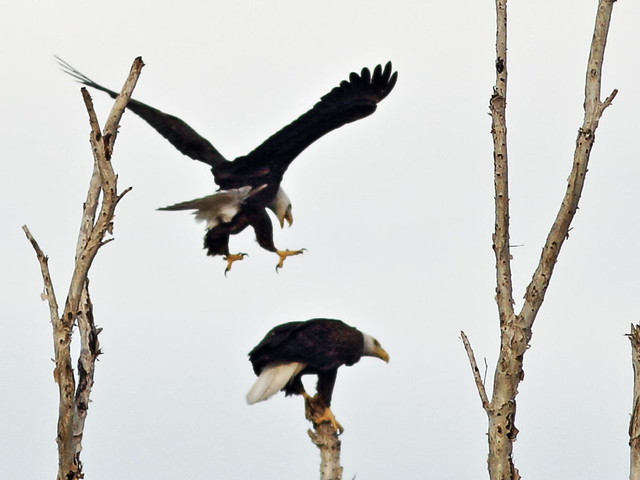
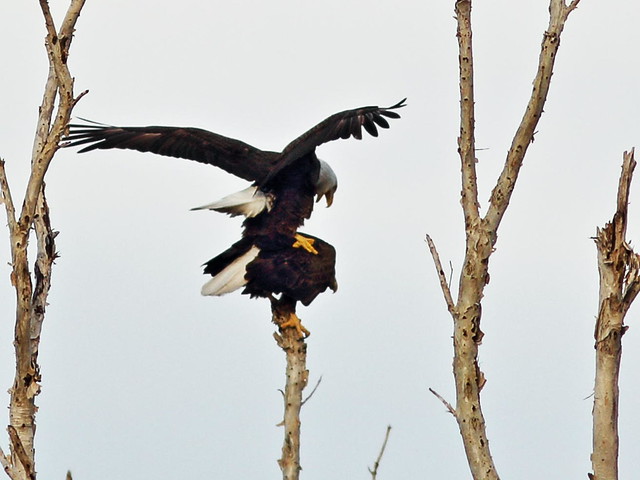
In mid-February the eagle watchers reported that an adult was persistently sitting deep in the nest, suggesting the possibility that a second clutch of eggs had been deposited. Then, on February 16, another swarm of severe storms swept through, depositing a second and much larger branch on the left side of the nest. Look closely at this photo and see that an adult continued to sit deep despite the new damage:
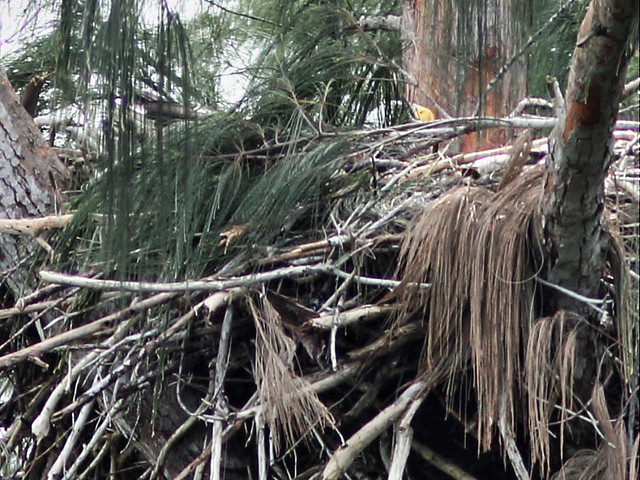
The eagles stayed on the nest and we feared that the male may have been sitting on one or more infertile eggs, but then both of the pair appeared to be incubating and our hopes were renewed. On March 16 both eagles were seen peering into the nest. They often do this when the first eaglet hatches.
On March 17 we received photographic evidence of at least one eaglet in the nest. I took this photo of them feeding a new offspring on March 24th:

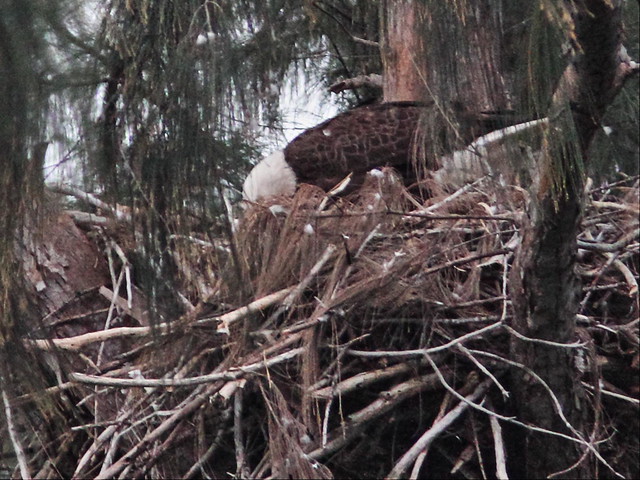
There were actually TWO eaglets seen in the nest by April 2. One eaglet was more active and aggressive:

The other was smaller and had more natal down:
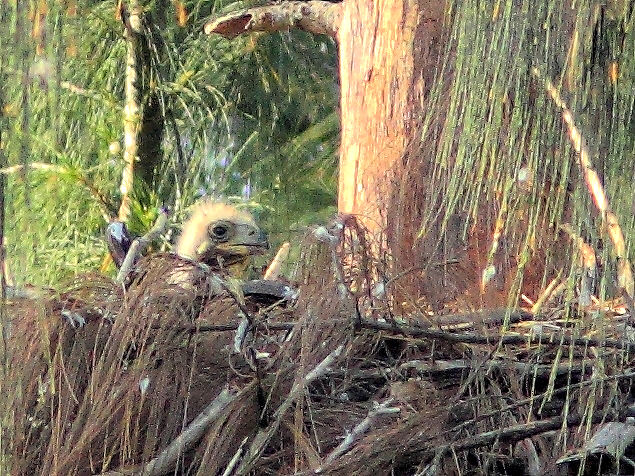
The older of the two appeared to be about 2 1/2 weeks old, suggesting it may have hatched on or about March 16. This meant that incubation of the second clutch of eggs began 5 weeks previously, around February 10, just before the second storm blew the other branch down over the nest. They have survived so far despite the adversity.
Here they were on April 7:
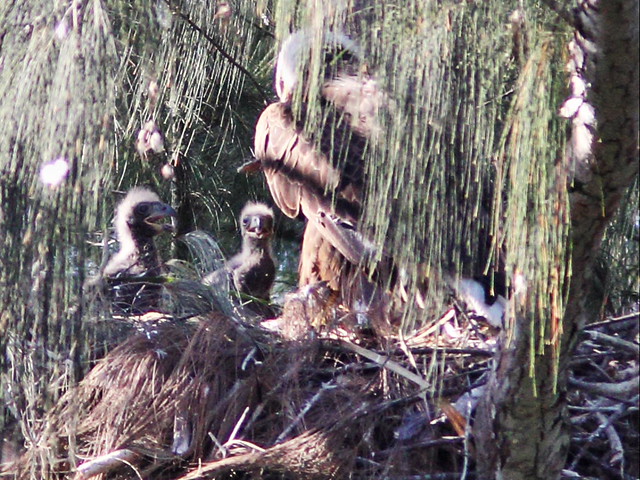
Pride was guarding the nest and flew down to check on the eaglets:
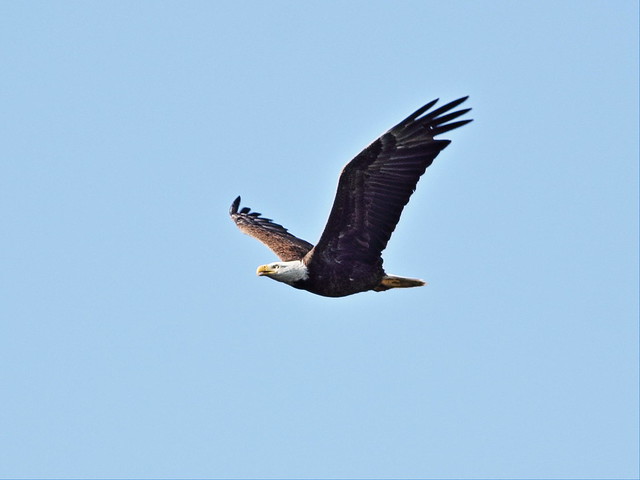
As we watched the nest, a family of Raccoons decided to cross the busy highway. We held our breath but they seemed wise enough to wait for a gap in the stream of vehicles:

One youngster (almost fully grown) was reluctant and lingrered behind.
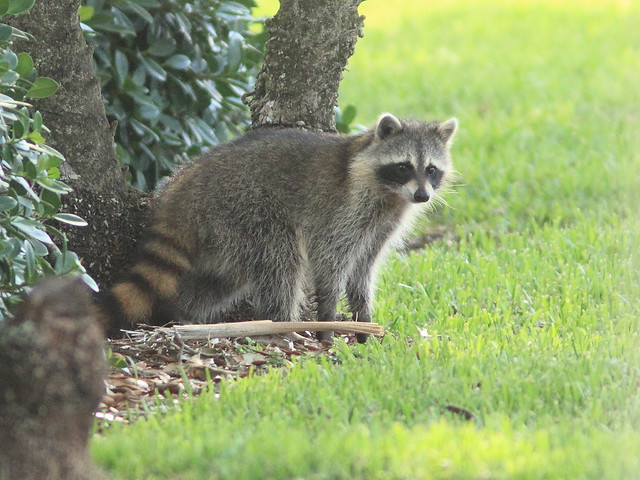
After a couple of false starts, it scooted across safely, just ahead of the traffic:
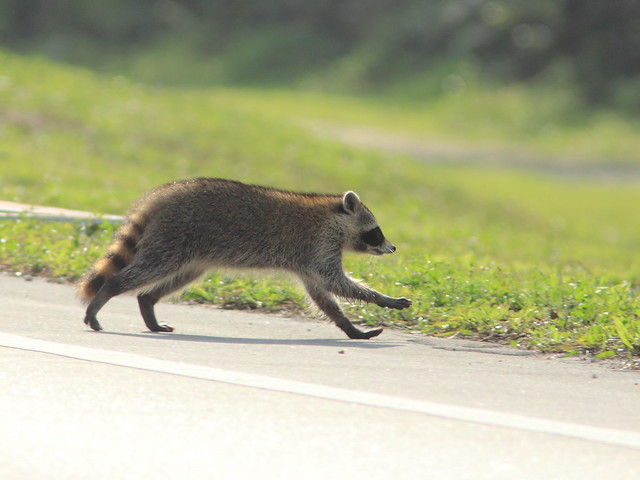
As I was ready to publish this, I had to add the big "BUT" to the title...
I posted this photo in my Bald Eagle Nest Watch FORUM on April 10, showing the older of the two eaglets. I was concerned because its aggressive behavior towards its nest-mate was quite obvious. I assumed that the younger chick was hiding but asked others to look for it and keep tabs on its welfare:

My concerns were justified the very next day, when one of the watchers actually saw and photographed the eaglet being attacked and killed by its sibling. Here is a link to her report of the horrific event. Scroll down to Kathy's post: One eaglet seen in nest -- other has been killed
In the event that you cannot bear watching this, here was my response:
!t is very sad to learn that the older and more aggressive eaglet killed the younger one. I feared it was being cowed into laying low or even already injured by the older one when I posted my message. Siblicide is one of the eagles' keys to success, as it gives the surviving eaglet a much better chance of becoming an adult.
As you may know, the first eaglet is more likely to be a female than a male, and she is larger than the male at all ages. The second is more likely a male, so there is a 1:1 sex balance. The first-hatched, if a female, is more likely to kill a second female, perhaps because it eliminates a competitor while she is still small and weak. A female and male sequence is the most successful combination for survival, maybe because the male learns his place in the hierarchy and does not challenge the female. This also assures a balance between the number of males and females as adults. If the first-hatched is a male the entire brood has less chance of surviving than if the first is a female.
Since south Florida eagles developed an instinct to breed much earlier than those up north, there were inherent advantages-- less heat stress on the eaglets and better prey availability when they are growing fastest in February and March. Let's hope that Pride and Jewel can provide for the single eaglet and see her fledge successfully sometime in late summer.
= = = = = = = = = = = = = = =
Linking to Misty's CAMERA CRITTERS,
Linking to Eileen's SATURDAY'S CRITTERS,
Linking to GOOD FENCES by Tex (Theresa).
Linking to WEEKEND REFLECTIONS by James
Linking to BirdD'Pot by Anni
Linking to Wild Bird Wednesday by Stewart
________________________________________________
Please visit the links to all these memes to see some excellent photos on display
________________________________________________
ohhhhhhhhh what wonderful captures.
ReplyDeleteI love skyscapes
Hello, I love the gorgeous sky shots. Awesome series on the Eagles and their young. It is sad that one eaglet can kill it's sibling. Happy Thursday, enjoy your day!
ReplyDeleteAwesome eagle shots and love the raccoons too!
ReplyDeleteHappy Weekend coming to you ~ ^_^
When I was reading it I had forgotten about the BUT at the beginning but then that is nature working correctly. I wonderful story adn photographs toillustrate it and I am sure you will keep us informed with the progress of the remaining click kenneth.
ReplyDeleteBrilliant captures, Kenneth! I also love your eagle header and beautiful green background!
ReplyDeleteYou are spot on Ken. The lateness of hatching(for Florida) probably caused the food supply to be not ideal and not enough to support two. I suspect the bigger one didn't actually "kill" the second one. It was pecking at it to show dominance like they do and the second one was too weak to take it. Sad but this is nature.
ReplyDeleteSuch a lovely sunrise over the wetlands. The raccoons were just so cute and those eagles are amazing. It saddens me to hear that the one killed the other one but I guess that is "nature's way." - I'm curious as to why their nest area can't be cleared to make it safer for them.
ReplyDeletevery sad, but i hope the stronger one will survive. i had 2 raccoons run out in front of my car this week, too.
ReplyDeleteWhat a story of those eagles!
ReplyDeleteThe sky photos are gorgeous.
I hate to hear that one did not survive, but hopefully the second one will. Well, actually, I guess more than one didn't survive, if you consider the entire spring.
ReplyDeleteOh, that sunrise sure was awesome.
Impressive sky and cloud reflection. Love seeing the eagles and the new eaglet.
ReplyDeleteSpectacular photos, Kenneth.
ReplyDeletePhantastic pictures and a gorgeous reflection of the clouds!
ReplyDeleteThe reflection photos are top notch and I love the eagle photos too.
ReplyDeleteBeautiful
ReplyDeleteexcellent photos....
ReplyDeleteAs an aside, a photo has been circulating with about 20 eagles sitting in a tree in a town about an hour north of where I live....Are you on facebook or instagram?? if so, search for Stan Enns to see the photo. I think they are part of a group of about 50 eagles that are still migrating north.
Hello ken, awesome post. I love all the eagle photos. Those darn raccoons are a problem here, I have to put my bird feeders away every night. Thank you for linking up and sharing your post. Have a happy weekend!
ReplyDeleteStunning shots of the eagle, love seeing your pics.
ReplyDeleteThat first pic is fantastic.
ReplyDeleteThe eaglet story is fascinating. "Nature finds a way" as the story goes...
~
Oh............I am heartbroken!!
ReplyDeleteHope you have a terrific week ahead, and thanks so much for participating and sharing your birds for us at I'd Rather B Birdin'.
Tho a sad outcome, I know, it would eventually find death because of being the 'weak link' of offspring I guess...but still. Excellent commentary Ken. And wonderful updates/showing the progress with photos.
Hard to respond to things like this without the use of the word cruel - but I suppose it's just nature.
ReplyDeleteA good - if sad - story (if you see what I mean)
Cheers - Stewart M - Melbourne
Your posts would make an awesome book! They are fascinating to read and see the photos! How exciting there was a second brood, but then sad about the death of the smaller male chick. Nature is so harsh! But, it is the way it is. I look forward to following the new chick in her life!
ReplyDeleteEagle lives are fraught with danger right from the beginning it seems. "Ours" so far are still doing OK -- the older eaglet has taken several flights and the younger is doing hops and wingersize on branches. ( can't seem to get good pictures, but I've seen them both. (The younger one is the one that was rescued by Rehab and returned to the nest...which still seems like a miracle.)
ReplyDeleteGorgeous skies and the raccoons are cute. I love the eagles. Let's hope the remaining eaglet will survive.
ReplyDelete